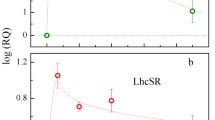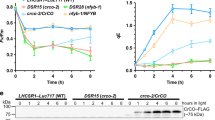Abstract
Transfer of Chlamydomonas reinhardtii cells grown photoautotrophically in low light to higher light intensities has a dramatic transient effect on the differential expression of the two major chloroplast encoded photosynthetic proteins. Synthesis of the D1 protein of Photosystem II increases more than 10-fold during the first six hours in high light (HL), whereas synthesis of the large subunit (LSU) of Rubisco drops dramatically within 15 min and only gradually resumes at about 6 h. Synthesis of the chloroplast-encoded ATP synthaseβ subunit, the nuclear-encoded Rubisco small subunit and the nuclear-encoded β-tubulin is not noticeably affected. Up regulation of psbA mRNA translation accounts for a substantial fraction of the increased D1 synthesis, since accumulation of psbA mRNA increases 4.2- and 6.3-fold less than D1 synthesis at 6 and 18 h in HL. Down-regulation of LSU synthesis is not correlated with a reduction in the steady-state level of the rbcL transcript. Primer extension mapping of the 5' ends of the rbcL mRNAs reveals transcripts with start points located at -93 and -186 relative to the first translated ATG. Transfer of low light (LL)-grown cells to HL temporarily decreases the ratio of the -93 to -186 transcripts, but this ratio normalizes after 6 h in HL, coincident with the recovery in the synthesis of LSU. These several distinct effects of temporary light stress were correlated with a rapid, sustained increase in the reduction state of QA, a transient decline in photosynthetic efficiency, a less rapid drop in total chlorophyll content and a delay in cell division.
Similar content being viewed by others
References
Allen JF, Alexciev K, Hakansson G: Regulation by redox signaling. Curr Biol 5: 869–872 (1995).
Anderson JM: Photoregulation of the composition, function and structure of the thylakoid membranes. Annu Rev Plant Physiol 37: 93–136 (1986).
Anderson JM, Osmond CB: Shade-sun responses: compromises between acclimation and photoinhibition. In: Kyle DJ, Osmond CB, Arntzen CJ (eds) Photoinhibition. Topics in Photosynthesis 9, pp. 1–38. Elsevier, Amsterdam (1987).
Barber J, Andersson B: Too much of a good thing: light can be bad for photosynthesis. Trends Biochem Sci 17: 61–66 (1992).
Chua N-H, Gillham NW: The sites of synthesis of the principal thylakoid membrane polypeptides of Chlamydomonas reinhardtii. J Cell Biol 74: 441–452 (1977).
Chow WS, Qian LP, Goodchild DJ, Anderson JM: Photosynthetic acclimation of Alocasia macrorrhiza (L.) G. Don to growth irradiance: structure, function and composition of chloroplasts. Aust J Plant Physiol 15: 107–122 (1988).
Danon A, Mayfield SP: Light-regulated translation of chloroplast messenger RNAs through redox potential. Science 266: 1717–1719 (1995).
Demmig-Adams B, Adams WW: Photoprotection and other responses of plants to high light stress. Annu Rev Plant Physiol Plant Mol Biol 43: 599–626 (1995).
Erickson JM, Rahire M, Rochaix J-D: Chlamydomonas reinhardtii gene for the 32 000 mol. wt. protein of photosystem II contains four large introns and is located entirely within the chloroplast inverted repeat. EMBO J 3: 2753–2762 (1984).
Escoubas J-M, Lomas M, LaRoche J, Falkowski PG: Light intensity regulation of cab gene transcription is signaled by the redox state of the plastoquinone pool. Proc Natl Acad Sci USA 92: 10237–10241 (1995).
Falkowski PG, LaRoche J: Acclimation to spectral irradiance in algae. J Phycol 27: 8–14 (1991).
Fisher T, Shurtz-Swirski R, Gepstein S, Dubinsky Z: Changes in levels of ribulose-1,5 bisphosphate carboxylase/oxygenase (Rubisco) in Tetraedron minimum (Chlorophyta) during light and shade adaptation. Plant Cell Physiol 30: 221–228 (1989).
Gillham NW, Boynton JE, Hauser CR: Translational regulation of gene expression in chloroplasts andmitochondria. Annu Rev Genet 28: 71–93 (1994).
Greenberg BM, Gaba V, Canaani O, Malkin S, Mattoo AK, Edelman M: Separate photosensitizers medicate degradation of the 32 kDa photosystem II reaction center protein in the visible and UV spectral regions. Proc Natl Acad Sci USA 86: 6617–6620 (1989).
Gruissem W, Tonkyn J: Control mechanisms of plastid gene expression. CRC Rev Plant Sci 12: 19–55 (1993).
Harris EH: The Chlamydomonas Sourcebook. Academic Press, New York (1989).
Herrin D, Michaels A: The chloroplast 32 kDa protein is synthesized on thylakoid-bound ribosomes in Chlamydomonas reinhardtii. FEBS Lett 184: 90–95 (1985).
Heifetz PB: Physiological, biochemical and ecological consequences of specific chloroplast gene mutations affecting synthesis and function of the photosystem II D1 protein in chlamydomonas. Ph.D. thesis, Duke University (1995).
Klein RR, Mason HS, Mullet JE: Light-regulated translation of chloroplast proteins. I. Transcripts of psaA-psaB, psbA and rbcL are associated with polysomes in dark-grown and illuminated barley seedlings. J Cell Biol 106: 289–301 (1988).
Krause G, Weis E: Chlorophyll fluorescence and photosynthesis: the basics. Annu Rev Plant Physiol Plant Mol Biol 42: 313–349 (1991).
Kyle DJ, Ohad I, Arntzen CJ: Membrane protein damage and repair: selective loss of a quinone-protein function in chloroplast membranes. Proc Natl Acad Sci USA 81: 4070–4074 (1984).
La Roche J, Mortain-Bertrand A, Falkowski PG: Light intensity-induced changes in cab mRNA and light harvesting complex II apoprotein levels in the unicellular Chlorophyte Dunaliella tertiolecta. Plant Physiol 97: 147–153 (1991).
Laemmli EK: Cleavage of structural proteins during the assembly of the head of bacteriophage T4. Nature 227: 680–685 (1970).
Lers A, Heifetz PB, Boynton JE, Gillham NW, Osmond CB: The carboxyl-terminal extension of the D1 protein of photosystem II is not required for optimal photosynthetic performance under CO2_ and light-saturated growth conditions. J Biol Chem 267: 17494–17497 (1992).
Mattoo A, Hoffman-Falk H, Marder JB, Edelman M: Regulation of protein metabolism: coupling of photosynthetic electron transport to in vivo degradation of the rapidly metabolized 32-kilodalton protein of the chloroplast membrane. Proc Natl Acad Sci USA 81: 1380–1384 (1984).
Maxwell DP, Laudenbach DE, Huner NPA: Redox regulation of light-harvesting complex II and cab mRNA abundance in Dunaliella salina. Plant Physiol 109: 787–795 (1995).
Mayfield SP, Yohn CB, Cohen A, Danon A: Regulation of chloroplast gene expression. Annu Rev Plant Physiol Plant Mol Biol 46: 147–166 (1995).
Melis A: Dynamics of photosynthetic membrane composition and function. Biochim Biophys Acta 1058: 87–106 (1991).
Osmond CB: What is photoinhibition: some insights from comparisons of shade and sun plants. In: Baker NR, Bowyer JR (eds) Photoinhibition: Molecular Mechanisms to the Environment, pp. 1–24. Bios Scientific Publishers, Oxford, UK (1994).
Osmond CB, Ramus J, Levavasseur G, Franklin LA, Henley WJ: Fluorescence quenching during photosynthesis and photoinhibition of Ulva rotundata Bild. Planta 190: 97–106 (1993).
Poulsen C: Two mRNA species differing by 258 nucleotides at the 5′ end are formed from the barley chloroplast rbcL gene. Carlsberg Res Commun 49: 89–104 (1984).
Prásil O, Adir N, Ohad I: Dynamics of photosystem II: mechanism of photoinhibition and recovery processes. In: Barber J (ed) The Photosystems: Structure, Function and Molecular Biology, pp. 295–348. Elsevier, Amsterdam (1992).
Rintamaki E, Salo R, Aro E-A: Rapid turnover of the D1 reaction-center protein of photosystem II as a protection mechanism against photoinhibition in a moss, Ceratodon purpureus (Hedw.) Brid. Planta 193: 520–529 (1994).
Reinbothe S, Reinbothe C, Parthier B: Methyl jasmonateregulated translation of nuclear-encoded chloroplast proteins in barley. J Biol Chem 268: 10606–10611 (1993).
Reinbothe S, Reinbothe C, Heintzen C, Seidenbecher C, Parthier B: A methyl-jasmonate-induced shift in the length of the 5′ untranslated region impairs translation of the plastid rbcL transcript in barley. EMBO J 12: 1505–1512 (1993).
Sambrook J, Fritsch EF, Maniatis T: Molecular Cloning, 2nd ed., 3 vols. Cold Spring Harbor Laboratory Press, Cold Spring Harbor, NY (1989).
Schmidt RJ: A study of chloroplast ribosome biogenesis and evolution in Chlamydomonas reinhardtii. Ph.D. thesis, Duke University (1984).
Schmidt RJ, Gillham NW, Boynton JE: Processing of the precursor to a chloroplast ribosomal protein made in the cytosol occurs in two steps, one of which depends on a protein made in the chloroplast. Mol Cell Biol 5: 1093–1099 (1985).
Schreiber U, Schliwa U, Bilger W: Continuous recording of photochemical and nonphotochemical chlorophyll fluorescence quenching with a new type of modulation fluorometer. Photosynth Res 10: 51–62 (1986).
Schuster G, Timberg R, Ohad I: Turnover of thylakoid photosystem II proteins during photoinhibition of Chlamydomonas reinhardtii. Eur J Biochem 177: 403–410 (1988).
Author information
Authors and Affiliations
Rights and permissions
About this article
Cite this article
Shapira, M., Lers, A., Heifetz, P.B. et al. Differential regulation of chloroplast gene expression in Chlamydomonas reinhardtii during photoacclimation: light stress transiently suppresses synthesis of the Rubisco LSU protein while enhancing synthesis of the PS II D1 protein. Plant Mol Biol 33, 1001 (1997). https://doi.org/10.1023/A:1005814800641
Issue Date:
DOI: https://doi.org/10.1023/A:1005814800641




